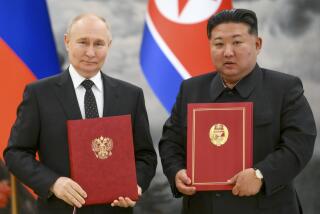U.S. and Russia Sign Agreement to Counter Nuclear Threat
- Share via
MOSCOW — The United States and Russia took their first step Thursday in a new program to reduce the risk of poorly guarded nuclear materials at research facilities around the world falling into the hands of terrorists.
“This will reduce the threat of terrorism and prevent the proliferation of weapons-grade uranium,” U.S. Energy Secretary Spencer Abraham told reporters after signing a bilateral agreement with Russian officials. Under the plan, the United States and other nations will pay for more than a dozen countries to send nuclear materials they received from Russia back to the Russians.
The agreement calls for all unused highly enriched uranium fuel that came from Russia to be returned by the end of next year. Spent fuel will be returned to Russia by 2010, Abraham said.
The Russian nuclear agency chief, Alexander Rumyantsev, who also signed the agreement, called it “a very important event because we know how to treat irradiated fuel” and because it reflects cooperation with the United States.
The program is part of a $450-million effort, announced by Abraham in Vienna on Wednesday, under which Washington and Moscow will seek to recover the most dangerous nuclear materials from foreign research reactors. Some initial reports on the announcement said the Russian-origin fuel was destined for the United States.
Fuel that originated in the United States is expected to be returned within a decade, Abraham said. Plans call for the most dangerous material to be returned first.
Both the United States and Russia are capable of reprocessing the materials into less dangerous forms and storing them more securely than they often are at foreign research centers.
Nuclear bombs can be made either from highly enriched weapons-grade uranium or from plutonium, which can be extracted from reprocessed spent fuel.
The materials that the program focuses on also could be used to make “dirty bombs,” which spread radioactive materials through conventional explosions.
Although highly radioactive materials at research facilities constitute only a tiny fraction of the nuclear materials around the world, they are of special concern because many such institutions are poorly guarded.
Some Russian experts say the U.S.-Russian agreement is only a modest move toward reducing risks.
It will be many years before all the materials are returned to Russia or the U.S., they say, and there are much greater quantities of radioactive materials at nuclear power plants than at research facilities.
“This is a very good step, but the problem is, it should have been done long ago,” said Alexei V. Yablokov, president of the Center for Ecological Policy of Russia, a Moscow think tank.
Over the last half a century, the United States has exported about 11,000 tons of uranium, and it appears that Russia also has shipped several thousand tons abroad, said Yablokov, who is one of Russia’s leading environmentalists. Much of the uranium can no longer be accounted for, he said.
“In principle, it is a very good idea to collect all the used nuclear fuel which has been spread all over the world, but it is also an impossible task,” Yablokov said. “A huge amount of it will remain undetected in different parts of the globe. Nuclear power plants in different countries will continue to be a powerful source of weapons-grade nuclear material.”
For these reasons, the U.S.-Russian agreement on research reactor fuel is “largely a political rather than a practical step,” he said.
Abraham also alluded to the political importance of the agreement.
“Today’s agreement represents a very important first step,” he said. “I look forward to increasingly close ties between our two nations as we work together to reduce the threat of terrorism and the vulnerability of nuclear and radiological materials throughout the world.”
Yablokov said there were “many tons of nuclear material still unaccounted for” in the world. Less than 200 pounds of weapons-grade uranium is enough to make “a working and powerful nuclear bomb,” while a dirty bomb can be made with less than a quarter-pound of not very highly enriched material, he said.
*
Times staff writer Sergei L. Loiko contributed to this report.
More to Read
Sign up for Essential California
The most important California stories and recommendations in your inbox every morning.
You may occasionally receive promotional content from the Los Angeles Times.













